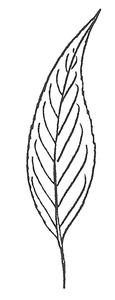Populus angustifolia (pop’-u-lus an-gus-ti-fol’-e-a)
Family: Salicaceae, Willow
Key Steps
- 1b – Alternate leaf arrangement — go to 18
- 18a – Leaf simple — go to 19
- 19b – Thornless — go to 22
- 22e – All leaves unlobed — go to 31
- 31c – Leaf is long and narrow (3-4 times longer than wide) — go to 37
- 37b – More than one bud scale — go to 39
- 39a – Stem yellowish-green to gray. Catkins drooping — Narrowleaf Cottonwood
- 37b – More than one bud scale — go to 39
- 31c – Leaf is long and narrow (3-4 times longer than wide) — go to 37
- 22e – All leaves unlobed — go to 31
- 19b – Thornless — go to 22
- 18a – Leaf simple — go to 19
Description
 Leaf: Narrow (3/4 to 1 1/2 inches wide) by 2-6 inches long. Broadest near the middle, round base, very pointed tip, finely toothed. Sticky underneath Short petiole. Stout yellow midrib (central vein).
Leaf: Narrow (3/4 to 1 1/2 inches wide) by 2-6 inches long. Broadest near the middle, round base, very pointed tip, finely toothed. Sticky underneath Short petiole. Stout yellow midrib (central vein).
Bud: Brown, sticky, 3-5 thin scales. 1/2 inch long. Slender, pointed. Lateral buds may be curved outward.
Leaf Scar: Oval, Three bundle scars.
Stem: Slender, round, smooth, yellow-green when young. Pale lenticels.
Bark: Gray furrowed.
Pith: Greenish to light brown, 5-pointed, solid.
Flower: Male and female on separate trees.
Fruit: Egg-shaped capsule on drooping catkins which release hairy brown seeds.
Habit: Tall, oval. Colorado native usually found along streambanks and wet areas. To 40 feet tall. Suckers.
Culture: High moisture requirement.
Resources




